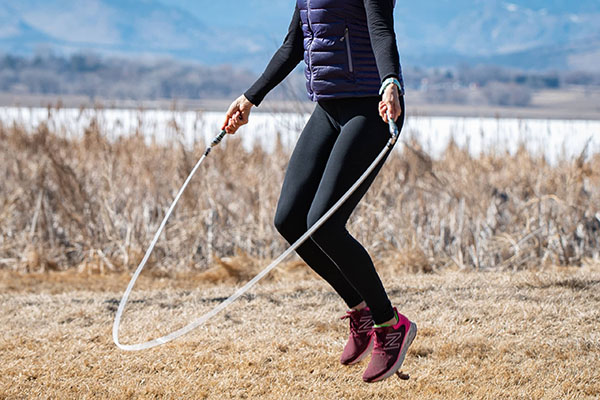Have you ever found yourself pondering the possibility that jumping might have the power to make you taller? It’s a question that has intrigued many, and for good reason. The idea that certain activities, like jumping exercises, can contribute to an increase in height has captured the imagination of individuals seeking to grow taller. In this article, we embark on a journey to uncover the connection between jumping and height gain. We will delve into the science behind this notion, exploring whether jumping has a genuine impact on vertical growth. Additionally, we’ll dissect the various factors that influence our height, shedding light on the complex interplay of genetics, nutrition, and lifestyle. And for those who are eager to maximize their height potential, fear not, for we will also provide you with practical tips to help you reach for the stars, quite literally. So, if you’ve ever wondered about the secrets hidden within the simple act of jumping, read on to uncover the truth about this intriguing phenomenon.
Does Jumping Rope Make You Taller?
As previously explored, the impact of jumping rope on height is rather limited, typically resulting in a modest gain of 1-2 inches at most. It’s crucial to grasp that your height is predominantly determined by your genetic makeup, and incorporating a consistent jumping rope routine will not magically bestow you with an additional 3-4 inches, as certain misconceptions may erroneously suggest. Poor posture can contribute to spinal curvature, which in turn can give the impression of diminished stature.
However, through steadfast dedication to jumping rope, you can effectively work on elongating your spine and mitigating compression, ultimately leading to improved posture and the illusion of increased height, typically within the range of 1-2 inches.
Furthermore, jumping rope holds the potential to assist with weight management. Regular engagement in this activity results in substantial calorie expenditure, which, in turn, can contribute to achieving a leaner physique. A trimmer body can create the optical illusion of heightened stature.
It is of paramount importance to temper expectations regarding the transformative influence of jumping rope on one’s height. While it does offer certain advantages, such as enhanced posture and a more svelte appearance, its effect on actual height augmentation remains quite minimal when juxtaposed with the predominant role of genetic factors

How Jumping Rope Makes You Taller
Jumping rope can have a profound impact on your posture and how you are perceived in terms of height. It achieves this through various mechanisms:
- Strengthening Core Muscles: Jumping rope engages the core muscles, including those in the abdomen and back. This engagement provides essential support to your spine, resulting in improved posture. When you maintain proper alignment, you naturally maximize your height potential.
- Enhancing Spinal Alignment: Jumping rope promotes proper spinal movement and flexibility. The rhythmic up-and-down motion during jumping helps align your vertebrae more effectively. Correct spinal alignment translates to better posture, ultimately making you appear taller.
- Stretching and Decompressing the Spine: The repetitive jumping and landing involved in rope skipping gently stretch and decompress your spine. This action creates a gentle traction force on the spinal column, relieving compression and pressure on intervertebral discs. This contributes to improved posture and height perception.
- Strengthening Leg Muscles: Jumping rope is a high-impact exercise that strengthens leg muscles, including the calves, quadriceps, and hamstrings. These strong leg muscles provide stability and support, enabling you to stand upright with better posture.
- Improving Overall Fitness: Regular jumping rope can enhance your overall fitness, including cardiovascular health, endurance, and coordination. When you are physically fit, you exude more confidence and maintain better posture, creating the impression of increased height.
While jumping rope can positively impact your posture and height perception, it’s crucial to remember that it won’t physically alter your height beyond your genetic potential. Nevertheless, by enhancing your posture and overall fitness, jumping rope can contribute to a more confident and taller-looking appearance.
The Benefits of Incorporating Jumping Exercises for the Illusion of Height Increase:
Engaging in jumping exercises, such as the rhythmic and dynamic act of jumping rope, can yield a visual transformation that gives the impression of enhanced stature. This effect is attributed to a combination of factors:
- Enhanced Posture: Jumping exercises exert a strengthening influence on the muscles of your back, core, and lower extremities, pivotal for bolstering your spinal column and sustaining impeccable posture. This newfound postural excellence translates into a more upright and stately bearing, which, in turn, creates the illusion of heightened stature.
- Spinal Decompression: Activities involving vertical jumps gently alleviate pressure on the spinal column. This temporary relief permits the spinal discs to expand slightly, resulting in a momentary elongation of the spine and the semblance of increased height.
- Elevated Muscle Tone: Consistent engagement in jumping exercises fosters the development of well-defined and taut musculature throughout your physique. Toned muscles bestow a more streamlined and lengthened aesthetic, rendering you appear taller by minimizing the visual prominence of surplus body fat or lax musculature.
- Augmented Confidence: Participation in jumping exercises has a propensity to boost self-confidence and heighten body awareness. Heightened confidence tends to manifest as improved posture and greater poise, both of which contribute to the perception of increased height and a more authoritative presence.
In summary, while jumping exercises do not alter your physical height, they can significantly enhance your posture and the way you are perceived in terms of height, leading to a more self-assured and towering appearance.
Essential Requirements for Commencing a Skipping Routine:
To embark on a skipping or jump rope regimen, you will need several fundamental items:
- Jump Rope: Select a jump rope that aligns with your height and proficiency level. A variety of jump rope types are available, including speed ropes (characterized by their lightweight and thin cables for swift rotations) and weighted ropes (heavier ropes that offer increased resistance). Opt for a jump rope that suits your preferences and aligns with your fitness objectives.
- Appropriate Footwear: Wear comfortable athletic shoes that provide adequate support and cushioning. Prioritize footwear with effective shock absorption to mitigate the impact on your joints during jumping. Avoid the practice of jumping rope barefoot or utilizing shoes lacking proper support.
- Sufficient Space: Locate a suitable area with ample room to jump rope freely. Ideally, a level and non-slip surface, such as a gymnasium floor, outdoor pavement, or a generously spacious room, is suitable. Ensure that there are no obstacles or potential hazards in close proximity that could disrupt your jumping session.
- Suitable Attire: Don comfortable workout attire that permits unrestricted movement. Opt for breathable fabrics that facilitate sweat evaporation and maintain comfort during physical exertion. Refrain from wearing loose or baggy clothing that might become entangled in the jump rope.
- Warm-Up and Cool-Down Routine: Prioritize a comprehensive warm-up and cool-down routine to prepare your body for the exercise and reduce the risk of injuries. Engage in dynamic stretches, such as arm circles, leg swings, or jumping jacks, to warm up your muscles before commencing the skipping session. Afterward, perform static stretches to aid muscle recovery and prevent post-exercise stiffness.
- Patience and Practice: Jumping rope may require some practice, especially if you are a beginner. Initiate your journey with fundamental jumps and progressively advance to more intricate techniques as your comfort and proficiency improve. Grant yourself the patience and time necessary to develop endurance and coordination.
Incorporating these essential elements into your skipping routine will ensure a safe and effective experience as you work towards your fitness goals.
How long do you need to jump to see results in height?
Jumping exercises, such as jumping rope, do not directly lead to an increase in your height beyond your genetically predetermined potential. Your ultimate height is predominantly determined by factors like genetics and the growth plates within your bones.
While engaging in jumping exercises can have positive impacts on your overall health, including enhancing your posture and strengthening your muscles, it does not result in a permanent increase in height. Any perceived height changes that may occur temporarily are usually attributed to improved posture and better body alignment.
To maximize the potential benefits of jumping exercises for your posture and overall well-being, it is advisable to maintain a consistent and regular workout routine. Aim for at least 30 minutes of moderate-intensity aerobic activity, such as jumping rope, on most days of the week.
It’s crucial to bear in mind that any alterations in height perception that arise from improved posture or enhanced muscle tone are likely to be minor and fleeting. If you have concerns regarding your height or growth, it is advisable to seek guidance and advice from a healthcare professional who can offer personalized recommendations.

What is the proper technique for jumping to increase height?
To achieve maximum jump height, it’s crucial to follow a specific set of techniques and guidelines. By adhering to these principles, you can optimize your jumping ability and potentially increase your jump height. Here are some key steps to consider:
- Maintain Proper Posture: Stand tall and maintain an upright posture throughout the entire jump. Keep your head aligned with your spine, relax your shoulders, and lift your chest. Avoid slouching or hunching forward, as this can limit your upward momentum.
- Engage Your Core: Activate your abdominal muscles to stabilize your torso and maintain good posture. This not only supports your spine but also prevents unnecessary strain on your lower back during the jump.
- Bend Your Knees Slightly: Maintain a slight bend in your knees to absorb the impact when you land. This helps reduce stress on your joints and ensures a smoother landing, reducing the risk of injury.
- Land Softly: Aim for a light and controlled landing by landing on the balls of your feet and rolling through to your toes. Avoid landing with a heavy impact or flat feet, as this can lead to discomfort and potential injuries.
- Establish a Consistent Rhythm: Develop a steady rhythm and pace while jumping. Begin with a basic two-foot jump and gradually progress to more advanced techniques as you become more comfortable and proficient.
- Keep Your Jumps Reasonably Low: Excessive height in your jumps is not necessary and may increase the risk of injury. Focus on achieving a height that is comfortable and within your capabilities.
- Start with Shorter Durations: Begin with shorter jumping sessions and gradually increase the duration as your fitness level improves. Listen to your body and avoid overexertion, as pushing too hard can lead to fatigue and diminished performance.
- Warm Up and Cool Down: Prioritize a proper warm-up and cool-down routine to prepare your body for exercise and prevent injuries. Incorporate dynamic stretches before jumping and static stretches afterward to help your muscles recover and maintain flexibility.
Benefits of Jumping Rope for Height Increase:
As shared by Howtogrowtaller.com, while jumping rope alone cannot directly impact your genetic height potential, it offers numerous benefits that can contribute to your overall growth and development. Here are some ways in which jumping rope can support your health and potentially influence your height perception:
- Improved Posture: Jumping rope engages various muscle groups, including those in your core and back. Strengthening these muscles can lead to better posture and alignment, making you appear taller and more confident.
- Increased Muscle Tone: Jumping rope is a comprehensive full-body workout that targets multiple muscle groups, such as the legs, arms, and core. Regular rope jumping can enhance muscle tone and definition, giving you a leaner and more elongated appearance.
- Enhanced Bone Health: As a weight-bearing exercise, jumping rope puts stress on your bones, which can stimulate bone growth and density. Strong bones contribute to a well-supported frame, potentially improving your posture and height perception.
- Improved Coordination and Balance: Jumping rope requires coordination, rhythm, and balance. By practicing these skills, you can enhance your overall body control, which may positively affect your posture and body alignment.
- Boosted Cardiovascular Fitness: Jumping rope is an excellent cardiovascular exercise that elevates your heart rate, improves stamina, and enhances lung capacity. A healthy cardiovascular system supports overall well-being and may contribute to a more active lifestyle, potentially impacting your height perception positively.
Some ways to jump rope to increase height
It’s important to clarify that jumping rope won’t magically make you grow taller beyond your genetic potential. Your height is primarily determined by factors such as genetics, nutrition, sleep, and overall health. However, if you’re interested in harnessing the potential benefits of jumping rope to enhance your posture and overall fitness, there are several effective techniques you can incorporate into your routine:
- Maintain Proper Form: To begin, it’s crucial to maintain proper form throughout your jump rope sessions. Stand tall with your head aligned with your spine, and keep your shoulders relaxed. Engage your core muscles to support your torso, which will help you maintain stability and reduce the risk of injury.
- Embrace the Light Bounce: When jumping rope, focus on executing a light bounce. Propel yourself off the ground using the balls of your feet. Avoid generating excessive impact or jumping excessively high, as these are not necessary for reaping the benefits of jump rope exercises.
- Start with Basic Jumps: Begin your jump rope journey with basic two-foot jumps. Ensure that both of your feet leave the ground at the same time and land simultaneously. Maintain a consistent rhythm, and gradually increase your speed as you become more comfortable and confident.
- Progress to Single-Leg Jumps: Once you’ve mastered the basics, challenge yourself by incorporating single-leg jumps into your routine. This variation will further enhance your balance and coordination. Alternate between jumping on one leg and the other while maintaining proper form and balance.
- Experiment with Variations: To keep your workouts engaging and target different muscle groups, experiment with various jump rope variations. These can include high knees (raising your knees toward your chest with each jump), double unders (spinning the rope twice for a single jump), or criss-cross jumps (crossing your arms in front of you while jumping).
- Integrate Interval Training: Elevate the intensity and cardiovascular benefits of your jump rope workouts by incorporating interval training. Alternate between periods of high-intensity jumping and active recovery. During recovery intervals, you can perform slower jumps or take short rest breaks.
- Gradually Increase Duration and Intensity: Start your jump rope sessions with shorter durations and lower intensity, and gradually build up as your fitness level improves. It’s essential to listen to your body and avoid overexertion or pushing yourself too hard too quickly to prevent injuries.
- Combine with Other Exercises: Consider adding jump rope exercises as a valuable component of a comprehensive fitness routine. Pair them with other exercises that target your core, back, and leg muscles to provide comprehensive support for improved posture and overall fitness.
In Conclusion:
In summary, jumping rope doesn’t directly contribute to an increase in height. Your height is primarily influenced by genetic factors and various lifestyle elements. However, jumping rope can indirectly enhance the perception of height by promoting proper posture and overall fitness. To optimize your height potential, focus on maintaining a healthy lifestyle that includes a balanced diet, regular exercise, adequate rest, and incorporating jump rope exercises as a beneficial part of your fitness regimen.
- Related post: Does Tennis Increase Height?



